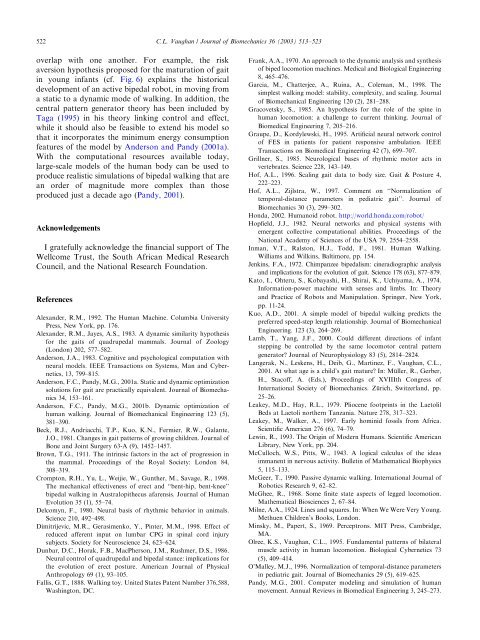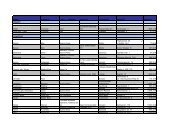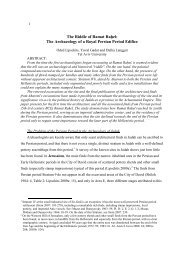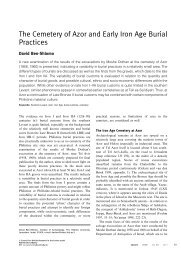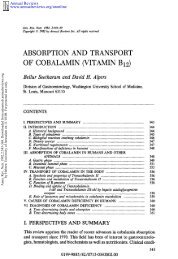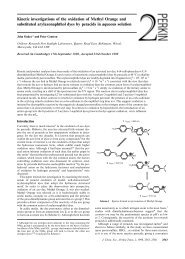Theories of bipedal walking: an odyssey
Theories of bipedal walking: an odyssey
Theories of bipedal walking: an odyssey
Create successful ePaper yourself
Turn your PDF publications into a flip-book with our unique Google optimized e-Paper software.
522C.L. Vaugh<strong>an</strong> / Journal <strong>of</strong> Biomech<strong>an</strong>ics 36 (2003) 513–523overlap with one <strong>an</strong>other. For example, the riskaversion hypothesis proposed for the maturation <strong>of</strong> gaitin young inf<strong>an</strong>ts (cf. Fig. 6) explains the historicaldevelopment <strong>of</strong> <strong>an</strong> active <strong>bipedal</strong> robot, in moving froma static to a dynamic mode <strong>of</strong> <strong>walking</strong>. In addition, thecentral pattern generator theory has been included byTaga (1995) in his theory linking control <strong>an</strong>d effect,while it should also be feasible to extend his model sothat it incorporates the minimum energy consumptionfeatures <strong>of</strong> the model by Anderson <strong>an</strong>d P<strong>an</strong>dy (2001a).With the computational resources available today,large-scale models <strong>of</strong> the hum<strong>an</strong> body c<strong>an</strong> be used toproduce realistic simulations <strong>of</strong> <strong>bipedal</strong> <strong>walking</strong> that are<strong>an</strong> order <strong>of</strong> magnitude more complex th<strong>an</strong> thoseproduced just a decade ago (P<strong>an</strong>dy, 2001).AcknowledgementsI gratefully acknowledge the fin<strong>an</strong>cial support <strong>of</strong> TheWellcome Trust, the South Afric<strong>an</strong> Medical ResearchCouncil, <strong>an</strong>d the National Research Foundation.ReferencesAlex<strong>an</strong>der, R.M., 1992. The Hum<strong>an</strong> Machine. Columbia UniversityPress, New York, pp. 176.Alex<strong>an</strong>der, R.M., Jayes, A.S., 1983. A dynamic similarity hypothesisfor the gaits <strong>of</strong> quadrupedal mammals. Journal <strong>of</strong> Zoology(London) 202, 577–582.Anderson, J.A., 1983. Cognitive <strong>an</strong>d psychological computation withneural models. IEEE Tr<strong>an</strong>sactions on Systems, M<strong>an</strong> <strong>an</strong>d Cybernetics,13, 799–815.Anderson, F.C., P<strong>an</strong>dy, M.G., 2001a. Static <strong>an</strong>d dynamic optimizationsolutions for gait are practically equivalent. Journal <strong>of</strong> Biomech<strong>an</strong>ics34, 153–161.Anderson, F.C., P<strong>an</strong>dy, M.G., 2001b. Dynamic optimization <strong>of</strong>hum<strong>an</strong> <strong>walking</strong>. Journal <strong>of</strong> Biomech<strong>an</strong>ical Engineering 123 (5),381–390.Beck, R.J., Andriacchi, T.P., Kuo, K.N., Fermier, R.W., Gal<strong>an</strong>te,J.O., 1981. Ch<strong>an</strong>ges in gait patterns <strong>of</strong> growing children. Journal <strong>of</strong>Bone <strong>an</strong>d Joint Surgery 63-A (9), 1452–1457.Brown, T.G., 1911. The intrinsic factors in the act <strong>of</strong> progression inthe mammal. Proceedings <strong>of</strong> the Royal Society: London 84,308–319.Crompton, R.H., Yu, L., Weijie, W., Gunther, M., Savage, R., 1998.The mech<strong>an</strong>ical effectiveness <strong>of</strong> erect <strong>an</strong>d ‘‘bent-hip, bent-knee’’<strong>bipedal</strong> <strong>walking</strong> in Australopithecus afarensis. Journal <strong>of</strong> Hum<strong>an</strong>Evolution 35 (1), 55–74.Delcomyn, F., 1980. Neural basis <strong>of</strong> rhythmic behavior in <strong>an</strong>imals.Science 210, 492–498.Dimitrijevic, M.R., Gerasimenko, Y., Pinter, M.M., 1998. Effect <strong>of</strong>reduced afferent input on lumbar CPG in spinal cord injurysubjects. Society for Neuroscience 24, 623–624.Dunbar, D.C., Horak, F.B., MacPherson, J.M., Rushmer, D.S., 1986.Neural control <strong>of</strong> quadrupedal <strong>an</strong>d <strong>bipedal</strong> st<strong>an</strong>ce: implications forthe evolution <strong>of</strong> erect posture. Americ<strong>an</strong> Journal <strong>of</strong> PhysicalAnthropology 69 (1), 93–105.Fallis, G.T., 1888. Walking toy. United States Patent Number 376,588,Washington, DC.Fr<strong>an</strong>k, A.A., 1970. An approach to the dynamic <strong>an</strong>alysis <strong>an</strong>d synthesis<strong>of</strong> biped locomotion machines. Medical <strong>an</strong>d Biological Engineering8, 465–476.Garcia, M., Chatterjee, A., Ruina, A., Colem<strong>an</strong>, M., 1998. Thesimplest <strong>walking</strong> model: stability, complexity, <strong>an</strong>d scaling. Journal<strong>of</strong> Biomech<strong>an</strong>ical Engineering 120 (2), 281–288.Gracovetsky, S., 1985. An hypothesis for the role <strong>of</strong> the spine inhum<strong>an</strong> locomotion: a challenge to current thinking. Journal <strong>of</strong>Biomedical Engineering 7, 205–216.Graupe, D., Kordylewski, H., 1995. Artificial neural network control<strong>of</strong> FESin patients for patient responsive ambulation. IEEETr<strong>an</strong>sactions on Biomedical Engineering 42 (7), 699–707.Grillner, S., 1985. Neurological bases <strong>of</strong> rhythmic motor acts invertebrates. Science 228, 143–149.H<strong>of</strong>, A.L., 1996. Scaling gait data to body size. Gait & Posture 4,222–223.H<strong>of</strong>, A.L., Zijlstra, W., 1997. Comment on ‘‘Normalization <strong>of</strong>temporal-dist<strong>an</strong>ce parameters in pediatric gait’’. Journal <strong>of</strong>Biomech<strong>an</strong>ics 30 (3), 299–302.Honda, 2002. Hum<strong>an</strong>oid robot. http://world.honda.com/robot/Hopfield, J.J., 1982. Neural networks <strong>an</strong>d physical systems withemergent collective computational abilities. Proceedings <strong>of</strong> theNational Academy <strong>of</strong> Sciences <strong>of</strong> the USA 79, 2554–2558.Inm<strong>an</strong>, V.T., Ralston, H.J., Todd, F., 1981. Hum<strong>an</strong> Walking.Williams <strong>an</strong>d Wilkins, Baltimore, pp. 154.Jenkins, F.A., 1972. Chimp<strong>an</strong>zee <strong>bipedal</strong>ism: cineradiographic <strong>an</strong>alysis<strong>an</strong>d implications for the evolution <strong>of</strong> gait. Science 178 (63), 877–879.Kato, I., Ohteru, S., Kobayashi, H., Shirai, K., Uchiyama, A., 1974.Information-power machine with senses <strong>an</strong>d limbs. In: Theory<strong>an</strong>d Practice <strong>of</strong> Robots <strong>an</strong>d M<strong>an</strong>ipulation. Springer, New York,pp. 11-24.Kuo, A.D., 2001. A simple model <strong>of</strong> <strong>bipedal</strong> <strong>walking</strong> predicts thepreferred speed-step length relationship. Journal <strong>of</strong> Biomech<strong>an</strong>icalEngineering. 123 (3), 264–269.Lamb, T., Y<strong>an</strong>g, J.F., 2000. Could different directions <strong>of</strong> inf<strong>an</strong>tstepping be controlled by the same locomotor central patterngenerator? Journal <strong>of</strong> Neurophysiology 83 (5), 2814–2824.L<strong>an</strong>gerak, N., Leskens, H., Deib, G., Martinez, F., Vaugh<strong>an</strong>, C.L.,2001. At what age is a child’s gait mature? In: M.uller, R., Gerber,H., Stac<strong>of</strong>f, A. (Eds.), Proceedings <strong>of</strong> XVIIIth Congress <strong>of</strong>International Society <strong>of</strong> Biomech<strong>an</strong>ics. Z.urich, Switzerl<strong>an</strong>d, pp.25–26.Leakey, M.D., Hay, R.L., 1979. Pliocene footprints in the LaetolilBeds at Laetoli northern T<strong>an</strong>z<strong>an</strong>ia. Nature 278, 317–323.Leakey, M., Walker, A., 1997. Early hominid fossils from Africa.Scientific Americ<strong>an</strong> 276 (6), 74–79.Lewin, R., 1993. The Origin <strong>of</strong> Modern Hum<strong>an</strong>s. Scientific Americ<strong>an</strong>Library, New York, pp. 204.McCulloch, W.S., Pitts, W., 1943. A logical calculus <strong>of</strong> the ideasimm<strong>an</strong>ent in nervous activity. Bulletin <strong>of</strong> Mathematical Biophysics5, 115–133.McGeer, T., 1990. Passive dynamic <strong>walking</strong>. International Journal <strong>of</strong>Robotics Research 9, 62–82.McGhee, R., 1968. Some finite state aspects <strong>of</strong> legged locomotion.Mathematical Biosciences 2, 67–84.Milne, A.A., 1924. Lines <strong>an</strong>d squares. In: When We Were Very Young.Methuen Children’s Books, London.Minsky, M., Papert, S., 1969. Perceptrons. MIT Press, Cambridge,MA.Olree, K.S., Vaugh<strong>an</strong>, C.L., 1995. Fundamental patterns <strong>of</strong> bilateralmuscle activity in hum<strong>an</strong> locomotion. Biological Cybernetics 73(5), 409–414.O’Malley, M.J., 1996. Normalization <strong>of</strong> temporal-dist<strong>an</strong>ce parametersin pediatric gait. Journal <strong>of</strong> Biomech<strong>an</strong>ics 29 (5), 619–625.P<strong>an</strong>dy, M.G., 2001. Computer modeling <strong>an</strong>d simulation <strong>of</strong> hum<strong>an</strong>movement. Annual Reviews in Biomedical Engineering 3, 245–273.


